Earth planet people types of economic activities. Presentation on the topic "human development of the earth"
Scientists find the beginnings of geographical knowledge among the peoples of the Ancient East - the inhabitants of Mesopotamia, Persia, Egypt, and Phoenicia. Farming and cattle breeding, trade, resettlement of peoples and wars led to the accumulation of knowledge about the world around. From the hieroglyphic inscriptions and drawings that have survived to this day, scientists have learned that as far back as 40 centuries BC, the Egyptians equipped expeditions to Central Africa, sailed along mediterranean sea. The geographical knowledge accumulated by the peoples of the East was expanded by great thinkers Ancient Greece. They tried to explain the origin and structure of the world around them, to depict the countries known at that time in the form of drawings (maps).
In the early Middle Ages, there is a decline in geographical knowledge. Wars, slave uprisings hindered the development of science. However, even at this time, many geographical discoveries were made. The leading role in them passed to the Arabs. Their ships plied the waters indian ocean. Arabs established colonies east coast Africa, traveled to China and India.
The knowledge of Europeans about earthly space also expanded significantly in the 13th century as a result of travels to Asian lands by Venetian merchants.
When capitalism replaced feudalism, again, as in ancient world increased interest in the sciences.
During the Age of Discovery, trade and navigation flourished. Portuguese and Spanish ships rush in search of ways to rich India. At the end of 1492 there was a discovery that became the greatest event in the history of mankind - H. Columbus discovered America. And in 1521 the first began circumnavigation under Magellan. The geographical horizon of Europeans expanded to unprecedented dimensions for that time. Thanks to these discoveries, people learned about the true size of their planet, about the ratio of land and water on Earth.
In the second half of the 17th and in the 18th century, travelers continued to search for new sea passages around the continents, new lands in the oceans, and explored the unknown sciences of the inner parts of the continents. During this period, scientific expeditions were organized for the first time, the purpose of which, along with discoveries, was to study and explain the causes of geographical phenomena and processes, the nature of individual territories.
Numerous expeditions of the 18th - 19th centuries and the beginning of the 20th century. enriched geography with knowledge about the nature and population of the Earth. During this era, the polar regions of our planet were discovered and explored.
The latest discoveries (20th century) have made a great contribution to the development of knowledge about our planet. They are carried out using new methods of studying the Earth in specially created scientific organizations, the purpose of which is to conduct scientific research. In many countries of the world, scientists organize large-scale expeditions to the Arctic and Antarctic. An extensive study of the World Ocean is underway. The beginning of his research was laid by the British expedition on board the Challenger, continued on the Russian Vityaz and other ships. In the 1960s, 67 countries took part in the exploration of the planet under the program of the International Geophysical Year.
For the first time, our compatriot Yuri Alekseevich Gagarin was lucky to see the sphericity and relief of the Earth from space, when on April 21, 1961 he circled the Earth in 108 minutes on the Vostok satellite ship.
> Problems of development of the Earth
Today, the Earth is studied from space, automatic stations are sent to other planets, their nature is compared with the nature of the Earth, and they get to know it more deeply as a part of the Universe. International scientific expeditions are also created, meetings are held, scientific information is being exchanged, but for all this time, man has not been able to fully develop the land. Even in our age, the age of information technology, the Earth is full of Mysteries and mysteries for us.
Man managed to penetrate into the depths of the earth only 12 - 15 km. Tunnels are being built, mines for mining, excavations are underway. And so we managed to study only that part of the lithosphere into which we really managed to penetrate.
The mantle of the planet has been studied very modestly. It is impossible to reach its depth in a natural way, and therefore scientists can explore it during volcanic eruptions.
The ocean is also poorly understood. It is not possible to penetrate to a depth of more than 200 km. Therefore, the bottom of the ocean is practically not explored.
Of course, using the most advanced equipment, people managed to get a rough idea of our planet. But approximate is not exact.
So why does man still fail to fully master the Earth?
There are a number of factors that prevent a person from penetrating into all spheres of the Earth, and above all, these are physical conditions. So the deepest mines are very difficult to build because there are no such strong materials that would withstand the pressure of the Earth. Also, as you know, the closer to the center of the Earth, the higher the air temperature (the core temperature is 1000 ° C), a risk to human life is created.
Due to the enormous pressure under the water, the equipment on the submarines can't stand it. Man has not yet managed to create such an underwater vehicle that could lower a person to the bottom of the sea without risk to life.
In permafrost conditions, it is very difficult to build roads, buildings, and to mine minerals. But still, the world has accumulated a lot of experience in construction and economic activity in permafrost conditions. In particular, in our country, such cities as Norilsk, Mirny Shatkin G.A. were built in harsh conditions. Our planet is the Earth // Science and Life.-1999.-№5, p.19-20..
slide 1
Earth exploration by man. Geography teacher MBOU secondary school №5 Nesterenko Irina Nikolaevnaslide 2
 The objectives of the lesson: to name and show the proposed ways of human settlement, the main areas of high population density on the Earth, the main types of economic activities of people; to give knowledge about human settlement on the continents; on the main types of economic activity of the population;
The objectives of the lesson: to name and show the proposed ways of human settlement, the main areas of high population density on the Earth, the main types of economic activities of people; to give knowledge about human settlement on the continents; on the main types of economic activity of the population;
slide 3

slide 4
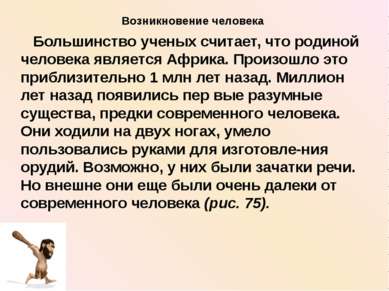 The emergence of man Most scientists believe that Africa is the birthplace of man. It happened about 1 million years ago. A million years ago, the first intelligent beings appeared, the ancestors of modern man. They walked on two legs and skillfully used their hands to make tools. Perhaps they had the beginnings of speech. But outwardly they were still very far from modern man (Fig. 75).
The emergence of man Most scientists believe that Africa is the birthplace of man. It happened about 1 million years ago. A million years ago, the first intelligent beings appeared, the ancestors of modern man. They walked on two legs and skillfully used their hands to make tools. Perhaps they had the beginnings of speech. But outwardly they were still very far from modern man (Fig. 75).
slide 5
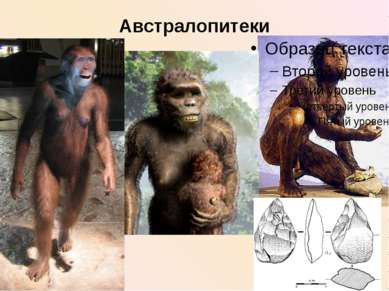
slide 6
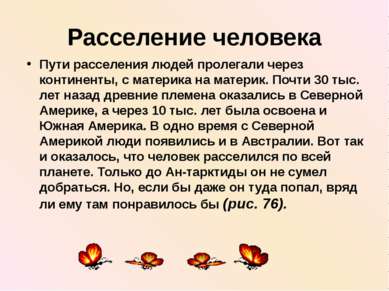 Human Settlement Ways of human settlement ran through the continents, from mainland to mainland. Almost 30 thousand years ago, the ancient tribes ended up in North America, and after 10 thousand years, it was mastered and South America. At the same time with North America people appeared in Australia. And so it turned out that man settled all over the planet. Only he failed to reach Antarctica. But even if he got there, he would hardly like it there (Fig. 76).
Human Settlement Ways of human settlement ran through the continents, from mainland to mainland. Almost 30 thousand years ago, the ancient tribes ended up in North America, and after 10 thousand years, it was mastered and South America. At the same time with North America people appeared in Australia. And so it turned out that man settled all over the planet. Only he failed to reach Antarctica. But even if he got there, he would hardly like it there (Fig. 76).
Slide 7
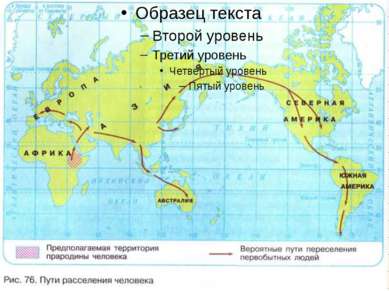
Slide 8
 Main areas of settlement South Asia East Asia Western Europe East End North America
Main areas of settlement South Asia East Asia Western Europe East End North America
Slide 9
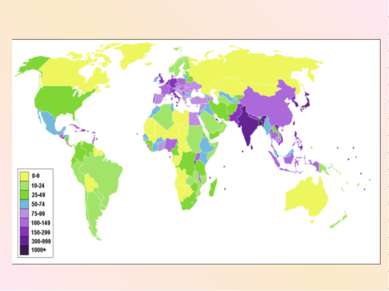
slide 10
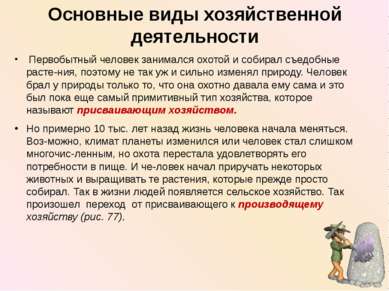 The main types of economic activity Primitive man was engaged in hunting and collecting edible plants, so he did not change nature so much. Man took from nature only what she willingly gave him herself, and this was still the most primitive type of economy, which is called the appropriating economy. But about 10 thousand years ago, human life began to change. Perhaps the climate of the planet has changed or man has become too numerous, but hunting has ceased to satisfy his needs for food. And man began to tame some animals and grow those plants that he had previously simply collected. This is how agriculture comes into people's lives. This is how the transition from an appropriating to a producing economy took place (Fig. 77).
The main types of economic activity Primitive man was engaged in hunting and collecting edible plants, so he did not change nature so much. Man took from nature only what she willingly gave him herself, and this was still the most primitive type of economy, which is called the appropriating economy. But about 10 thousand years ago, human life began to change. Perhaps the climate of the planet has changed or man has become too numerous, but hunting has ceased to satisfy his needs for food. And man began to tame some animals and grow those plants that he had previously simply collected. This is how agriculture comes into people's lives. This is how the transition from an appropriating to a producing economy took place (Fig. 77).
slide 11
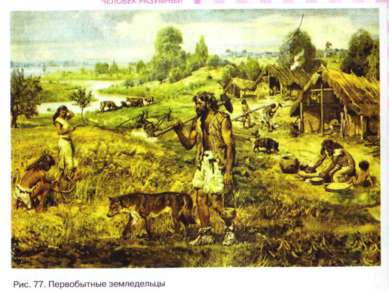
slide 12
 The production economy of the XVII century The production economy continued to develop. For many centuries, all the items necessary for a person to live: clothes, shoes, furniture, dishes, tools, weapons - were produced by artisans in numerous, but small workshops. By the 17th century handicrafts could no longer provide goods for the growing population. And it gave way to industry (Fig. 78).
The production economy of the XVII century The production economy continued to develop. For many centuries, all the items necessary for a person to live: clothes, shoes, furniture, dishes, tools, weapons - were produced by artisans in numerous, but small workshops. By the 17th century handicrafts could no longer provide goods for the growing population. And it gave way to industry (Fig. 78).
To enjoy preview presentations, create a Google account (account) and sign in: https://accounts.google.com
Slides captions:
Human settlement of the earth. Races. 7th grade
What is the main difference between Earth and other planets? The presence of a person
The first stage of development is preceded by intensive evolution of higher apes. There are different forms of great apes that inhabited Europe, southern and South East Asia, Africa. Dryopithecus are the ancestors of the gorilla, chimpanzee and man. 20-25 million years ago.
Australopithecus - Eastern and South Africa. 6 - 2 million years ago.
Prezinjantrop - Tanzania (East Africa), the age of the find is about 2 million years.
The first finds of Homo erectus were skeletal remains found in Asia (Pithecanthropus), Eastern and North Africa(Olduvai Man and Atlanthropus) and Europe (Heidelberg Man), where they appeared about 1 million years ago.
Modern man (Homo sapiens) appeared in Africa only about 200 thousand years ago.
The transition to a settled way of life occurred 11 thousand years ago. This contributed to the development of ancient civilizations. Civilization (from Latin - citizen) is a certain stage in the development of society, its material and spiritual culture.
The long existence of people in various natural conditions led to the emergence of races. Race (from the French race - genus, breed) - a historically established community of people with external signs transmitted by inheritance. There are four races: Negroid, Mongoloid, Caucasoid, Australoid.
Caucasian race
Mongoloid race
Negroid race
australoid race
Mulattos are descendants of mixed marriages of representatives of the Negroid and Caucasian races.
Mestizos are descendants of interracial marriages (Caucasoids and Indians).
Sambo - descendants of mixed marriages of blacks with Indians.
The Malgashi are a people, the main population of Madagascar, combining in their appearance signs of the Negroid and Mongoloid races.
Uninhabited territories
On the topic: methodological developments, presentations and notes
presentation "Population of the earth by man" Grade 6
Presentation of the history of human settlement of the earth, the influence of various living conditions on the formation of races ....
Summary of a lesson in geography in grade 7. Theme of the lesson: “The development of the Earth by man. Countries of the world."
1. Name and show the proposed ways of human settlement, the main areas of high population density on the Earth, the main types of economic activities of people, know ...
Earth exploration by man
Topic: HUMAN EARTH DEVELOPMENT. Objectives: - to name and show the proposed ways of human settlement, the main areas of high population density of the Earth, the main types of economic activity ...
1. Why in different places the globe Is the population density different?
For a long time, mankind settled on the territory of the Earth, gradually accumulating in places most favorable for living (for example, the valleys of the Nile, Indus, Ganges, the interfluve of the Tigris and Euphrates, where the so-called "river civilizations" were formed). Further development society has shown that, despite the desire of the state to equalize the population density across the country, people themselves tend to live where the climate is more comfortable for human habitation. The main population of Russia is concentrated in the center and south of the European part, the population of Canada - and the southern regions, China - in the east and southeast (Great Chinese Plain).
2. What types of economic activities of people change natural complexes especially strongly?
A person in the course of his economic activity violates the natural interaction between natural components in natural complexes. In areas with the highest population density, these impacts are most significant.
3. How has the economic activity of the population in your area changed the natural complexes?
Using various sources of information (newspapers, magazines, radio and television reports, etc.), determine which type of economic activity of the population in your area causes the greatest harm to nature. Suggest your ways of optimizing (smoothing out contradictions) in the interactions of nature and man in the process of economic activity of society.
4. On which continents are there especially many countries? Why?
At present, people constantly live on all continents (except Antarctica, where there are only scientific stations and the population changes periodically).
On all other continents, people live in the territories of different states. On each of the continents, a different number of states was formed. Compare the number of countries in Eurasia and Africa - these continents have the largest number of countries and various peoples that these countries form and form. At the same time, only one country was formed in Australia.
The geographical position of countries located on the same continent can vary significantly. It can be an island country, a peninsular country, a landlocked landlocked country.
5. Name the countries in which special natural phenomena are currently taking place (volcanic eruptions, earthquakes, hurricanes, floods, etc.), as well as important events in the life of peoples.
Give examples of countries most prone to natural disasters natural phenomena and apply them to contour map. Find and sign active volcanoes, indicate the years of the last destructive earthquakes.
This page searched for:
- how the economic activity of the population in your area has changed natural complexes
- name the countries in which special natural phenomena are currently occurring
- what types of economic activities of people most strongly change natural complexes
- Why are population densities different in different parts of the world?
- countries currently experiencing special natural phenomena
Goals:
- to give a figurative idea of the ways of human settlement on the continents;
- identify the main areas of the modern distribution of the population;
- form an idea of the uneven settlement of the planet and identify the causes of uneven settlement;
- to acquaint with the "comprehensive map" and the map "Population density";
- to form the skills of working with various sources of information;
- to form the worldview “I am a resident of the planet Earth”;
- develop spatial thinking.
Didactic structure of the lesson:
I. Organizational moment
II. Setting learning objectives for the lesson
- So, we have studied with you all types of natural landscapes. Now there are almost no natural landscapes left on Earth that a person would not change as a result of his activities. And there are almost no territories left that are not inhabited by humans. Even in Antarctica there are people who study the ice cover, relief and climate of the mainland.
And where did the first people appear and how did they populate all the continents? This is what we are going to talk about today.
Students write down the topic and lesson plan. ( Appendix 1 . Slides 1, 2)
III. Learning new material
1. Human settlement on the continents
? - Remember from the 6th grade course and ancient history: where, on what territory did the first person appear? Why?
Analysis of the scheme of human settlement on the continents (Slide 3)
2. Main areas of settlement
There are currently about 6 billion people on earth (Slides 4-6). But the population is extremely unevenly distributed.
? - In what places do you think the population should be higher: in the mountains, on the plains, along river valleys, near the oceans?
I listen and amend student responses.
- Let's identify the most densely populated territories of the Earth with you. To do this, we need to refer to the "Population Density" map, open it in your atlases.
The students were given the task to get acquainted with this map at home, to find out what information it contains. I ask questions about this.
The students were given an advanced task, to find a definition and explanation in the Internet source - what is population density. I propose to answer this question, then the correctness of the answers is checked with the teacher(Slide 8)
? – What do you think, what reasons (factors) influence such placement?
By talking with students, we identify the factors of population distribution. (Slide 9)
slide 10 (climate)
Slide 11 (natural areas)
slide 12 (relief)
slide 13 (currents)
? – What other factors affect population density?
Write down in a notebook. (Slide 14)
Factors:
1) natural conditions;
2) minerals;
3) prescription of settlement of the territory;
4) historical factor
3. Types of human economic activity.
- So, we have already determined that one of the factors of human settlement is minerals and favorable natural conditions. These conditions are prerequisites for various economic activities of people.
? –
What types of business activities do you know?
Being engaged in economic activities: cultivating land, mining, etc., a person changes the nature of the earth. Wherein different kinds activities affect nature in different ways.
I suggest that students read the text on pages 74-75 of the textbook from the words “Especially strong, etc. ... I voice the questions in advance that will be asked after reading the text.
? What type of economic activity has the greatest impact on nature? Give examples of such an impact.
? What impact does industry have on nature?
- Information about the economic activity of the population contains complex maps.
4. Introduction to complex maps
I propose to determine from the legend what information the map contains, what objects are shown on the map.
5. Countries of the world
So, we already know that the world's population is not evenly distributed. People living in the same territory, speaking the same language and having a common culture, form a historically established group - ethnos. Great ethnic groups later formed into states.
- On the map "population density" determine the most populated countries in the world.
IV. Conclusion
1st option: So, let's try to summarize everything that we talked about today in the lesson. And as a test of the knowledge gained today, we will answer the questions:
What territory is the ancient homeland of man?
What continents were the last to be inhabited?
- What is population density?
2nd option. If there is more time left, then I offer individually-oriented tasks:
3rd option: filling in the log book.
V. Homework: I suggest that students choose D / Z according to their strength.
- § 16 read and answer the questions of the paragraph (satisfactory)
- read § 16 and write test questions (good)
- for pleasure - "The dependence of dwellings (occupations, costumes) of the peoples of the world on natural conditions." (Great)
- educational project “Dwellings of the peoples of the world” (excellent)


